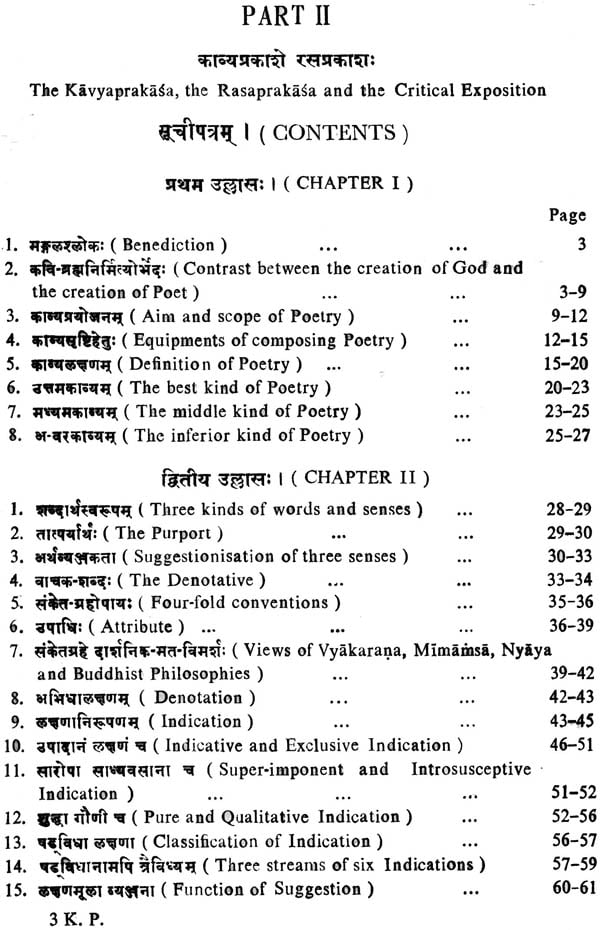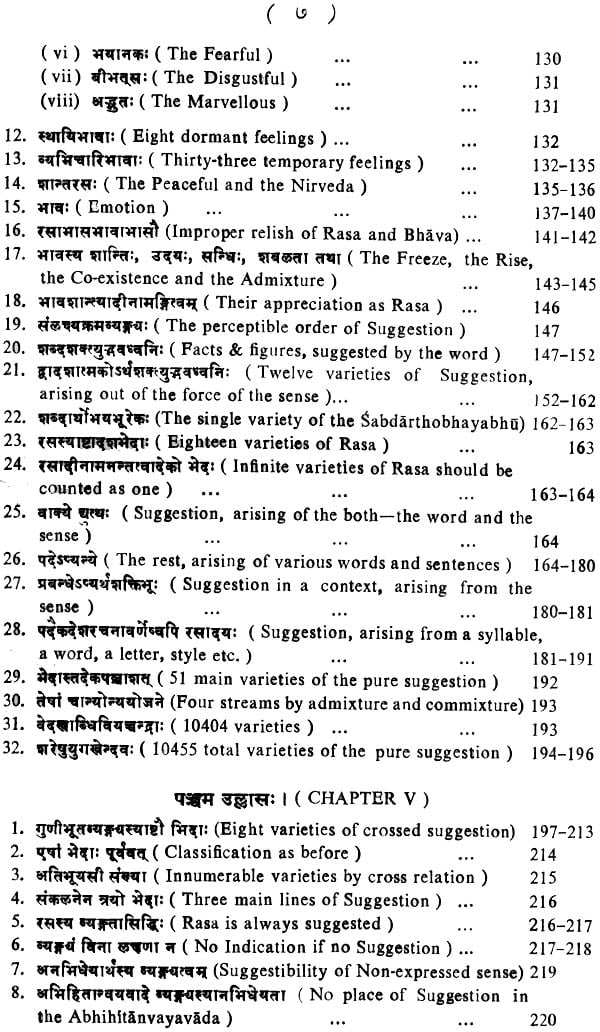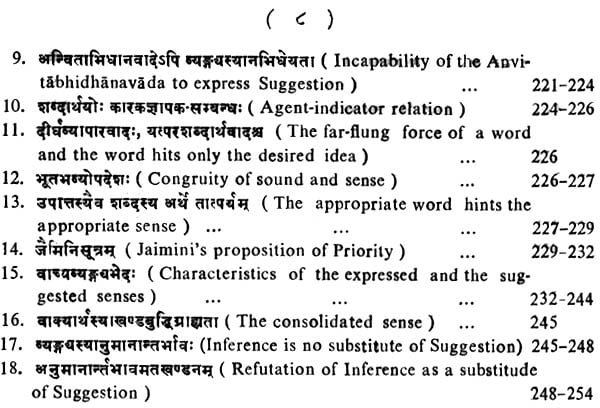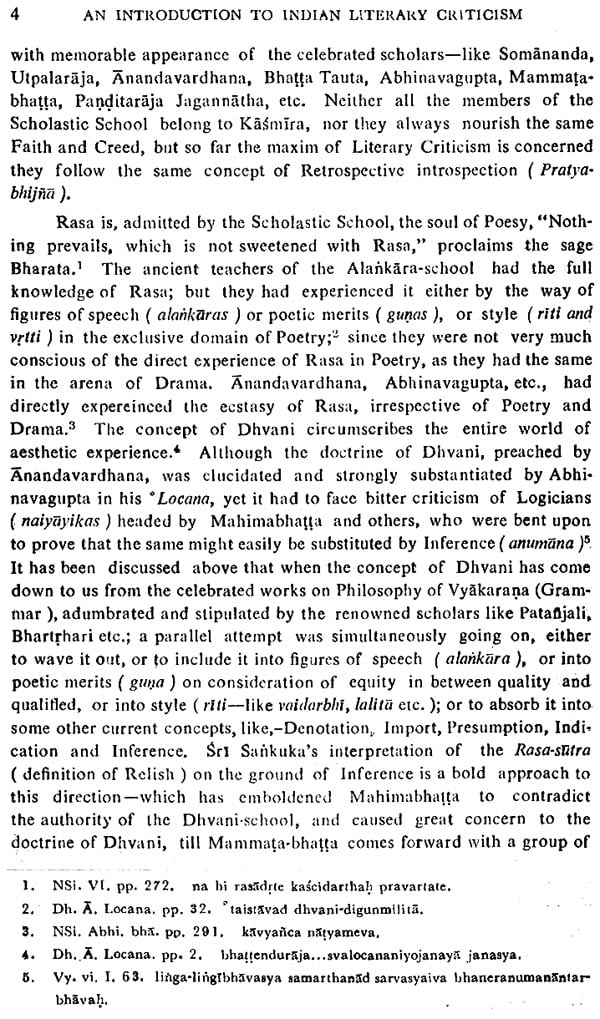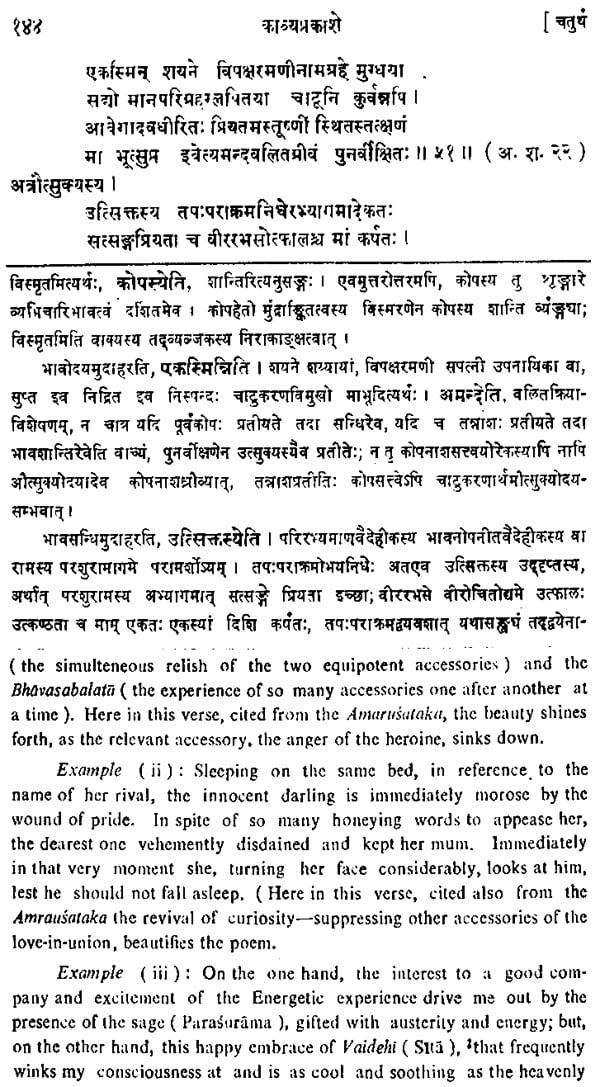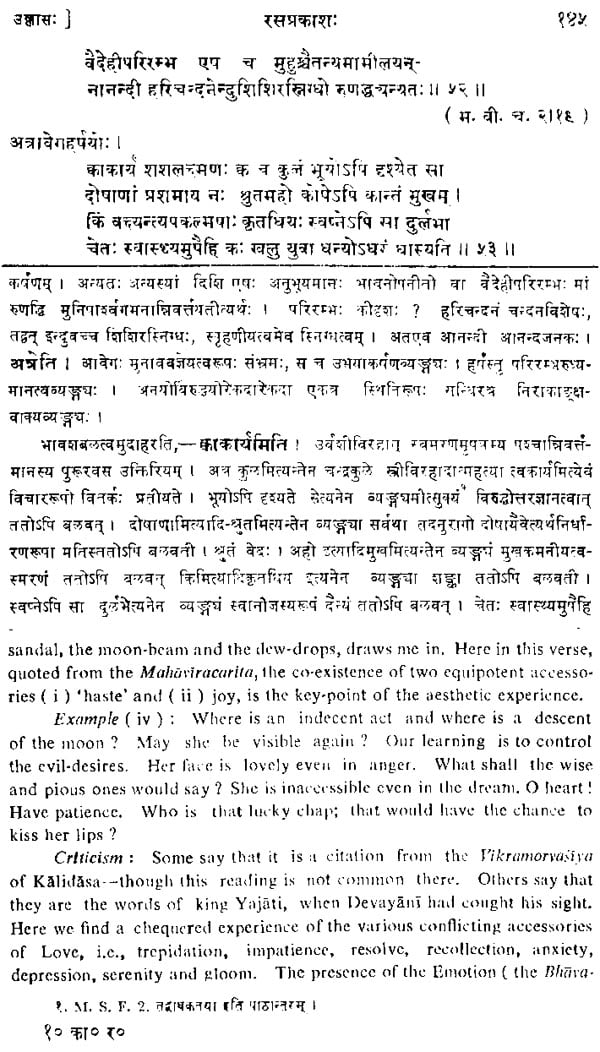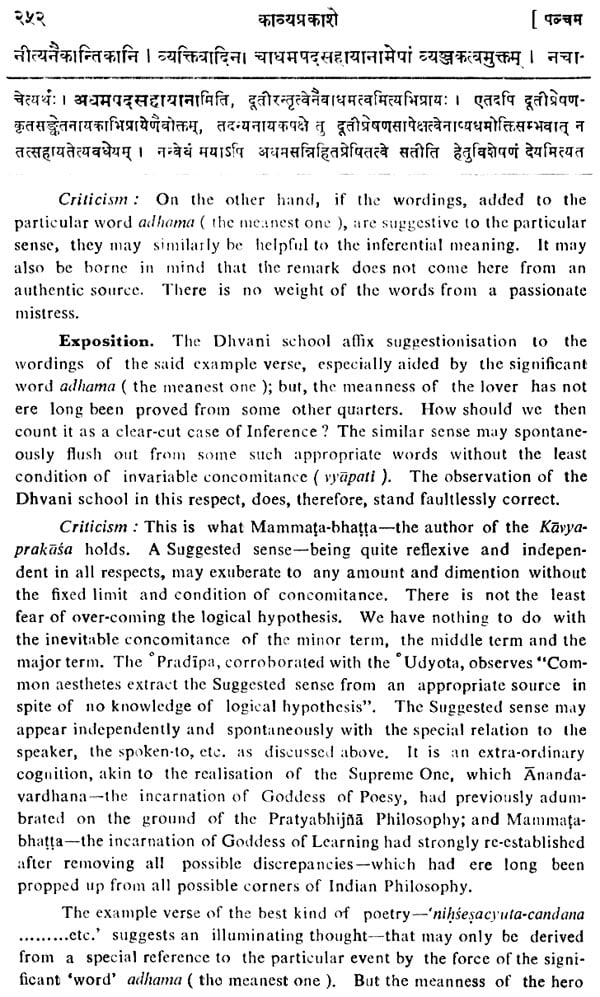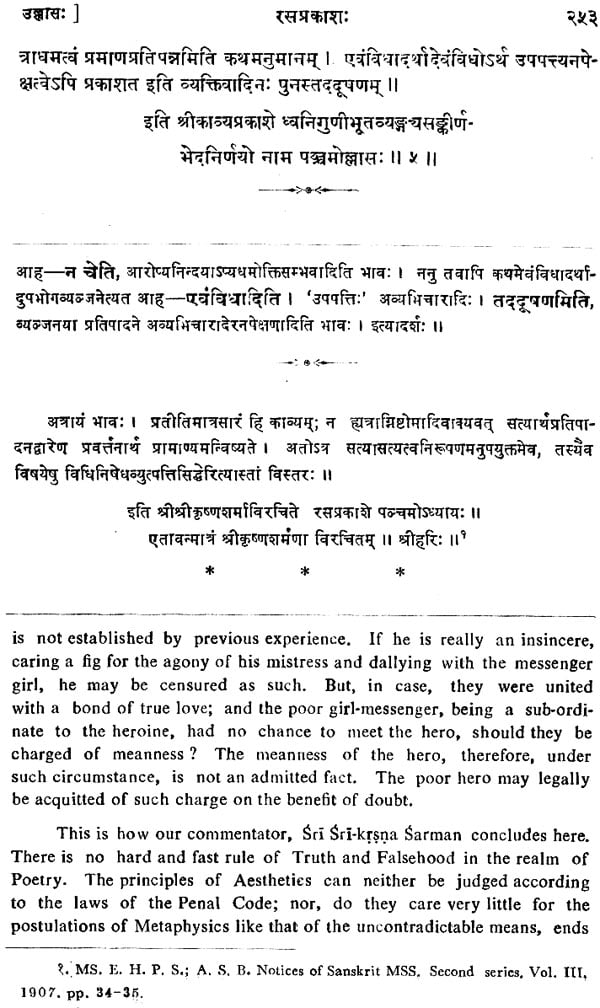
Kavya-Prakasa of Mammata-Bhatta
Book Specification
| Item Code: | NAH053 |
| Author: | Dr. S.N. Ghosal Sastri |
| Publisher: | Chaukhambha Bharati Academy, Varanasi |
| Language: | Sanskrit Text with English Translation |
| Edition: | 1973 |
| Pages: | 289 |
| Cover: | Hardcover |
| Other Details | 10.0 inch X 6.5 inch |
| Weight | 740 gm |
Book Description
I had the pleasure of going through Dr. Shivanarayana Ghosal Sastri’s edition of “Kavyaprakasa-Rasaprakasa” a commentary on Mammata-Bhatta’s Kavyaprakasa by Sri Srikrsna Sarma of the 17th. century A. D. with the text and “An Introduction to Indian Literary Criticism” by the learned editor. The commentator confines his commentary to the first five Chapters only in which there is Rasaprakasa (flash of relish) and ignores the last five which are devoid of it. The aim of the commentator is to write an impartial commentary, which elucidated Mammata-Bhatta’s real thought; to amend and to justify the views of his teacher Mahesvara Nyayalankara as presented in his Adarsa, a commentary on the Kavyaprakasa, and to reconcile the conflicting ideas of his predecessors from Sridhara, the author of the Kavyaprakasa-viveka, to Haridasa.
Sri Srikrsna Sarma is an important commentator on the Kavyaprakasa in so far as he makes us familiar with the views of many commentators on the Kavyaprakasa on important aspects of the problem of Rasa.
“An Introduction to Indian Literary Criticism” is extensive, learned, informatory and illuminative. It deals with the Scholastic school of Indian Aesthetics, mainly represented by Abhinavagupta, who bases it on the monistic Saiva Philosophy of Kashmir and touches upon the Divine school, presented by the Vaisnava saints. It points out that Anandavardhana’s concept of Arthi Vyanjana possibly finds its source in the Tantra-sastra, particularly the Pingala-mata of the Jayadratha Yamala.
The book has been scientifically edited. Enunciations, expositions and criticisms in foot-notes, make the edition very useful to the English reader. The editor is an expert manuscriptologist and a good Sanskrit scholar, possessed of the power of expression in chaste English, keen historical sense and acute critical faculty.
I am sure the book will be found useful by those who are interested in Indian Aesthetics and hope that it will have wide publicity. I heartily congratulate Dr. Shivanarayana Ghosal Sastri on this valuable production.
The Kavyaprakasa, the critical exposition of the Kavyalaksana, the conventional definition of Poetry; is traditionally appreciated as an akara-grantha (central work) of the Kavya-sastra (Indian Poetics); since a team of celebrated scholars confederated in Varanasi under the worthy leadership of Mammata-bhatta,-highly honoured as 'an incarnation of Goddess of Learning', to reconstitute an all-time central work on Indian Literary Criticism in the 11th. century A. D., what may assimilate and reconcile, in a nut-shell, all the ways and views of Indian Aesthetics and Rhetorics. This monumental work had earned so vast a popularity-that one may find a commentary on it 'in the nook of each and every house of Indian scholars.' So far as the biggest treasure of richest commentaries is concerned, it occupies the second place, next to the Srimad-Bhagavad-Gita; 'yet it remains as difficult as it always had been.'
The extra-ordinary characteristics of the Kavyaprakasa. Out of the four main streams of Indian Literary Criticism; Poetics, Dramaturgy, Poetic diction and Prosody; the Kavyaprakasa represents the complete Philosophy of Poetics-that has also two major branches, Rhetorics and Aesthetics. Although Aesthetics is appreciated a branch of Poetics in the field of Indian Literary Criticism; yet it is itself a full- fledged Philosophy and the nucleus of the whole system, -around which grow and move other aspects of the complete system of Indian Literary Criticism. We may, otherwise, consider Aesthetics, one of the main streams of Indian Literary Criticism, which has two main branches -Poetics and Rhetorics. The Principles of Indian Literature are fundamentally based on the One-in-Two concept of the Sense and the Sound- what is practically a compact of letters, -varnasamuhah padam; which form a word, frame a sentence and compose Literature, 'and represent the universal sense of the extra-ordinary verbal creation of men of letters'; what our Esoteric science observes as visible forms of the Formless One, li pilaksyavigrahah. Poetics and Dramaturgy are basically the two major streams of it, which include Poetic Diction, Rhetorics and Prosody, although they too, have their independent status of being a complete treatise of the literary science in their own respective fields of study.
The Philosophy of Indian Literary Criticism always welcomes the best thoughts and principles of other Philosophies to substantiate its supernatural and super-sensuous concepts,-which neither abide with God-made laws of Nature; nor with the man-made 'isms' of other mundane Philosophies. This uncommon-ness of Indian Aesthetics attracted intellectuals of all walks to elucidate the principles of Indian Literary Criticism on- the ground of their own Faith, Philosophy, Cult and Occult. But, very few of them could stand the adverse criticism of opponents towards the faithful expositions of literary principles.
The Rasaprakasa of Sri-Sri-Krsnasarman is virtually a commentary on the commentaries on the Kavyaprakasa,-that evaluates and reassesses the views of predecessors, as laid down in their respective commentaries. Srikrsna Sarman directly follows the foot-prints of Mahe- svara-nyayalankara in commenting on the Rasagrantha (the text of Aesthetics) as discussed in the first half of the Kavyaprakasa, i.e. from chapter-I to chapter-V. His contribution may practically be appreciated as a faithful re-commentary on Mahesvara-nyayalankiira's Adarsa or Bhavartha-cintamani, not always in the way of Nagesa's "Udyota and Vaidyanatha's Prabha, on Govinda Thakkura's Predipa; but, sometimes by way of chapter-wise exposition and sometimes by comprehensive elucidation; and thus, he paves a new avenue in the realm of Indian Literary Criticism; what is, likely, followed by his' successors, like Nagesa and Vaidyanatha.
Intrusion of Modern Logic to the field of Indian Literary Criticism. In the mediaeval period of Indian History, the persistent study in Navya-Nyaya (Modern Logic) cast imperishable impressions almost on all scholastic studies of the time. The Philosophy of Aesthetics and Literary Criticism have no exception. The distinguished scholars of mediaeval and modern periods had a fad to write commentaries on Poetics, especially on the Kavyaprakasa, the central work of Indian Literary Criticism; though they do neither conceptually believe in the concept of Suggestion; nor in the theory of Supernaturalism. Consequently,' their discourses on Indian Literary Criticism were more salted with logical concepts, rather sweetened and perfumed with the essence of Aesthetics. Too much philosophization in the field of Literary Criticism was never appreciated by the dedicated aesthetes. Before the supremacy of Logic on the Literary and Cultural life of India, the Philosophies of Vyakarana (Grammar) and Mimamsa (Philosophy of Vedic Rituals) had enjoyed an over-all supremacy on all walks of Indian life, what resulted in a reaction that "grammarians and dried-up Mimamsakas (Vedic ritualists) had no sense of Aesthetics", in spite of the accepted fact, that 'Rhetorics is an appendix to the Philosophy of Grammar, termed conventionally as Vakya-paka and Kavya-paka. (maturity in composition and poetization)
Exploration of the Nadia-school in the field of Aesthetics. The Kavya- prakasa-vistarika of Paramananda-Cakravartin is supposed to be the first commentary, made by a staunch logician of the Nadia-school, although Sri Srikrsna Sarman believed that he had taken necessary aids of other systems, wherever necessary. His commentary had, no doubt, an all- India recognition; but in course of time, scholars of Navadvipa felt that it required fresh amendment and clarification. Mahesvara-nyaya- lahkara came forward to shoulder the responsibility and refined the anomalous points of dispute in his commentary, the Kavyaprakasadarsa. What fanned an air of rivalary between the two groups of scholars- the followers of Paramananda-Cakravartin and the admirers of Mahe- svara-nyayalankara, headed by Sri Srikrsna Sarman. Mahesvara-nyaya- lankara, commonly known as a logician, was practically a versatile genius with equal command on other streams of Learning of the time. Like Vyakaranas (Grammars of various schools) Smrti (Social Science) Nyaya-Vaisesika (modern and ancient Logic), Kavyasastra (Poetics) etc., who marked the insufficiency and dependency of the then Indian Literary Criticism on the Nyaya system and proceeded to comment on the Kavyaprakasa, to remove the bias of dogmatism, sectarianism and syllogism; which crept into his predecessors' commentaries on the Kavyaprakasa, especially into Parmananda's Vistarika. He was also a scholar of all-India reputation with an equal recognition in the two principal seats of Learning, Navadvipa and Varanasi; yet he had to face adverse criticism of opponents, particularly of the followers of Paramananda- Cakravartin. His worthy students and followers took the mission of justifying his stand in elucidating principles of Literary Criticism; what directly reflected on the Rasaprakasa of Sri Srikrsna Sarman, particularly through the exposition of the Rasasutra (definition of Rasa).
Two currents of Indian Aesthetics. Indian Aesthetics has two main currents. One is the multi-sentimentalistic stream, appreciated mainly in Dramaturgy and refined particularly by the aesthetes of the Scholastic school. This branch is pioneered by celebrated Kasmrian scholars like Anandavardhana, Utpalaraja, Bhattanayaka, Bhattenduraja, Bhattatauta, Abhinavagupta, Mammata-bhatta and others. As the Rasaprakasa is a commentary on the Kavyaprakasa on Mammata-bhatta; who leaves no stone unturned to explain concepts of Indian Aesthetics and Literary criticism in his monumental work; it may fitly be admitted to the Scholastic School of Indian Aesthetics and Literary Criticism. “The Critical Exposition of Text” represents and re-estimates thoughts and principles of Indian Aesthetics and Literary Criticism of the Scholastic school, as occurred in the Kavyaprakasa. We feel, therefore, no need of preparing a separate Critical Study in Principles of Indian Literary Criticism. “An Introduction to Indian Literary Criticism” here practically re-estimates History and Philosophy of Indian Aesthetics and Literary Principles-re-valuated up-to-date, in the nature of “Higher Textual Criticism” of the present work. The other is the mono-sentimentalistic current, especially appreciated in erotic Poetry as discussed in the Agni purana, Bhagavata-purana etc. and refined by Anandavardhana, Bhoja, Bhanudatta, Rupagosvamin, Madhusudana Kavindra, Madhusudana Saraswati etc., what has been discussed in details by the present writer in his Rasacandrika and Studies in Divine Aesthetics, Vol. I and II, published by Visva-Bharati, Santiniketan.
The text of the Rasaprakasa. Historians enlisted the Rasaprakasa in the category of “less known commentaries” on the Kavyaprakasa. No where a complete codex of the same is yet traceable. We have seen only five MSS. of the same, preserved in different MSS. Libraries in India and abroad. Only nineteen folia of it had been first discovered by Mm. Haraprasad Sastri from a remote village of Comilla, East Bengal, now in Bangaladesh. This is possibly the same MS. now deposited in the MSS. Library of Asiatic Society of Bengal, Calcutta. The next is noticed in the Cabaton Catalogue of Bibliotheque Nationale, Paris, which reads upto the end of Chapter of Bibliotheque Nationale, Paris, which reads upto the end of Chapter III. The third one is the Visva-Bharati MS., collected probably by Pt. Anantakrsna Sastri, under the supervision of celebrated manuscriptologists, Professors M. Winternitz and Sylvan Levi, before 1924, and re-traced in 1963-4 from a heap of unclassified MSS., deposited in the Sanskrit MSS. Section, Vidya-Bhavana, Visva-Bharati. This copy comments upto the Rasasutra (Definition of Rasa) in the Kavya-Prakasa, Chapter IV. The fourth is the fragment MS. of the Rasaprakasa –beginning just from the last but one verse of the Chapter III, upto the mid-point of Chapter V, with some breaks in Chapters IV and V; deposited in the MSS. Library of Governmetn Sanskrit College, Calcutta. The next is an incomplete variant of the same, deposited in the collection of Sarasvati-bhavana MSS. Library, Varanaseya Samskrta Visva-Vidyalaya (Sanskrit University) Varanasi, which reads upto the complete text of the Rasasutra. With the help of these various recensions of the Rasaprakasa and some rare variants of the Kavyaprakasadarsa of Mahesvara-nyayalankara, as referred to in Chapter IV of 'An Introduction to Indian Literary Criticism'; the present text of the Rasaprakasa is constituted with necessary 'Lower Textual Criticism.' In addition to the Rasaprakasa, some other works of Sri Srikrsna Sarman, have recently been noticed in the "Descriptive Catalogue of Sanskrit MSS. deposited in the Sanskrit MSS. Section, Visva-Bharati, Vol. I". The historical and textual merits of such MSS. have also been evaluated in the 'Preface' of the same, by the present writer. Sri Sri- krsna Sarman, the author of the Rasaprakasa, has ere long been presumed identical with Krsnavadhuta --the author of the Mandaramaranda-campu, Advaitanavanitam etc. But this presumption goes evidently against the historical truth on the basis of facts and evidences, supplied in the relevant chapters of Part-I of the present work.
An Introduction to Indian Literary Criticism. The first part of the present work, entitled-'An Introduction to Indian Literary Criticism', is virtually the 'Higher Textual Criticism' of the text. It represents ~ brief and up-to-date study in History and Principles of Indian' Aesthetics and Literary Criticism, which have been discussed in details in other works of the present writer: 'Studies in Divine Aesthetics' and 'Elements of Indian Aesthetics'. For the benefit of majority of students, interested in Indian Aesthetics and Literary Criticism in India and abroad, we thought it better to elucidate the idea of the Kavyaprakasa- text, by the name of 'the Critical Exposition of the text,' in the same device of the original author-- Mammata-bhatta : (i) Enunciation; ( ii) Exposition, ( iii ) Exemplification and ( iv ) Criticism as reproduced in Sri Srikrsna Sarman's Rasaprakasa.
The ancient problem of authorship in the Kavyaprakasa is not yet completely solved in spite of persistent attempts since the time of Manikyacandra (1159 A. D.). A series of zealous debate and dissertation on the subject finds fresh impetus again from the later decades of the 19th. century; but, could reach no solution. An inclination to vote for the single-authorship bias had been marked among majority of modern scholars. Our commentator takes special interest in the vexed problem of the dual-authorship theory in the Kavyalaksana (Karika ) and the Kavyaprakasa (Vrtti). To justify his stand we have tried to dig out roots of the problem, analysed critically the 'motif behind the single-authorship theory and placed all the cards on the table for scholars' judgement.
Fact-finding and discovery of truth are the primary duty of a manuscriptologist--what compelled the present writer to review opinions of our worthy predecessors with a sportsmanly spirit.
Un-avoidable hurdles for research scholars. We read big and en- couraging words in reports of learned manuscriptologists, but find practically very little to trickle down from administrative bottle-necks in the time of need. The authority of Visva-Bharati very kindly permitted me to publish the present work by "some outside agency subject to the condition that due acknowledgement should be made of the facts-that the MSS. of the Visva-Bharati have been utilized and the research work has been done at Visva-Bharati."
I approached with the conditional proposal to late lamented Sri Jaikrishnadasji Gupta and Sri Krishnadasji Gupta, proprietors of the Chowkhamba Sanskrit Series, Varanasi, who appreciated my effort and encouraged me to prepare this humble work with a critical ex- position of the text for the benefit of students in India and abroad.
My best wishes go to their worthy sons--the present proprietors of the Chowkhamba Sanskrit Series, who fulfilled the pious desires of the departed souls.
The service of the Chowkhamba Vidyabhavana to the advancement of Oriental Learning. The Chowkhamba Vidyabhavana-that publishes various series of learned works of Oriental studies, by the name of the Chowkhamba Sanskrit Series, is more like an Institution for the advancement of Oriental Learning, than a mere publishing concern. Late Sri Jaikrishnadasji Gupta took a life-long vow to serve the scholars of Varanasi, inviting them to edit distinguished works and unpublished MSS. of high academic importance. He had formed a habit to see daily celebrated scholars of VariiQ.asi by turn, and used to pick up some promising students, studying under them, for the editorial service in the office of the Chowkhamba Sanskrit Series, under the loving care of late Sri Krishnadasji Gupta. I am glad that this humble work is enrolled into the commemoration series, dedicated to their holyjmemory.
Acknowledgment: The critical edition of the commentary' Rasa- prakasa with the text, Kavyaprakasa, would have never come out; if I could not enjoy valued advice, guidance and co-operation of the distinguished scholars, Research Institutions and MSS. Libraries, noted below. I extend my heart-felt gratitude on behalf of me and on behalf of Visva-Bharati to Bibliotheque Nationale, Paris, for the microfilmed copy of the incomplete MS. of the Rasaprakasa, deposited there.
I am equally grateful to the Principal, Govt. Sanskrit College, Calcutta, and personally to Professor Dr. Gourinath Sastri for his valued guidance and kind permission to utilize the facsimile of the Rasaprakasa, deposited in the MSS. Library of Sanskrit College, for the purpose of connecting the link-points with other incomplete MSS. and emendation of lacunae. My indebtedness to the authorities of Sarasvati-bhavana MSS. Library, Varanaseya Samskrta Visva-vidyalaya, (the Sanskrit University) Varanasi, is gratefully acknowledged. In connection with my research for this critical edition, I thrice visited the Sarasvati- bhavana MSS. Library from 1964 to 1972 and utilized the maximum number of MSS. deposited there. I have always enjoyed the warm welcome there and best co-operation of the Library Staff. I am very thankful to The Asiatic Society, Calcutta, for lending me the incomplete MS. the Rasaprakasa, for the purpose of collation. I am also highly obliged to Akhil Bharatiya Sanskrit Parisad, Lucknow, for lending me the MS. of Vistarika of Paramananda Cakravartin, that paves the new avenue of logicians' slyte of commenting on the Kavyaprakasa.
I express a deep sense of gratitude to Professor Dr. Siddhesvara Bhattacharya, Dean of the Faculty of Arts, Benaras Hindu University, for his valued suggestions. I am particularly grateful to Professor, Dr. V. Raghavan, the retd, Head of the Department of Sanskrit, Madras University, for an invaluable reference to the "Higher Textual Criticism" of the work.
I offer my heartfelt gratitude to Professor Dr. B. N. Banerjee, Head of the Department of Sanskrit, Pali and Prakrta, Visva-Bharati, for his constant co-operation and co-ordination. I am extremely grateful to the authority of Visva-Bharati for counting the present edition, a Research work, done at Visva-Bharati. The University very kindly permitted me to publish it from an outside agency and provided me with all possible aids, whenever necessary. I am also thankful to Sri Satkari Mukhopadhyaya (junior) for his editorial service, when he was among us. The work would have come out better and earlier, if we could enjoy his efficient service regularly.
Apology. Printing of this Research volume started in December, 1968. We allotted requisite time and took all possible cares, needed for a Research Publication; but, I regret that I could not read all the proofs myself from a distance of more than 600 km.; although an author himself is always a very bad proof-reader and can hardly escape 'psychic errors.' This has resulted in creeping some 'printer's devils,' which are mended in Errata and will duly be corrected in its next edition.
None can claim that he has hit the exact idea of the Kavyaprakasa of Mummata-bhatta, who had all along been honoured as an incarnation of Goddess of Learning. Manikyacandra, the earliest commentator on the Kavyaprakasa, realised that ‘those who write often slip’. I do not expect an exception. But, I would only beg to submit in the words of Mahesvara-nyayalankara, “doso vicara-sulabho yadi dusyatam tat, duye na tatra.” If there is a fault and that is justifiable, please blame it; I have nothing to regret.
| Foreword | vii-viii | |
| Preface | ix-xvi | |
| Chapter I | Principles of Indian Literary Criticism | 3-30 |
| Chapter II | The Kavyaprakasa And Its Comment Aries | 30-36 |
| Chapter III | Srikrsna Sarman And His Rasaprakasa | 37-47 |
| Chapter IV | The Text Constituted | 48-58 |
| Chapter V | Commentators Referred to By Our Author | 59-84 |
| Chapter VI | Problem of Authorship in The Kavyaprakasa | 85-107 |
| Chapter VII | More About “Mala Tu Purvavat” | 108-136 |
| Appendix -A. | 137-151 | |
| Appendix -B. | 152-154 | |
| Bibliography and Abbreviation | 155-162 | |
| Errata | 163-170 |
